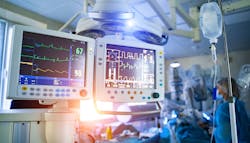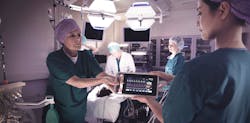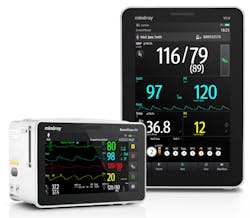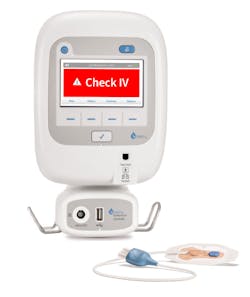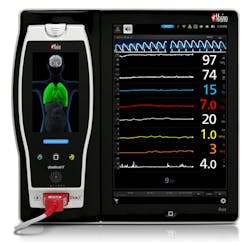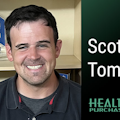Monitoring patients effectively and efficiently is as important to hospitals and health facilities as watching the market is to stockbrokers.
However, the potential problems in patient monitoring are numerous; when these problems are not managed and/or eradicated, they can evolve from pests into plagues.
Some of the most common problems in patient monitoring today come with alarm settings, complicated artifacts, information overload, tangled cables, issues switching between monitors made from different manufacturers, and difficulties arising from human performance.
Fortunately, many companies are continually stepping up with new and better solutions to handle inefficiencies in patient monitoring.
Staying flexible
Neal Sandy, General Manager, Monitoring Solutions, GE Healthcare, talked about the evolution of patient monitoring over time, and, in particular, how the COVID-19 pandemic prompted the need for change.
“In the past, patient monitors were generally purchased for a specific care area. For example, hospitals had specific monitors for the intensive care unit (ICU) and different monitors, typically with fewer capabilities, for the emergency department (ED). However, the COVID pandemic highlighted the need to have flexible patient monitoring technologies that could easily adapt to meet a patient’s acuity level. As hospitals had to quickly adjust from normal to surge operations to respond to the increase in COVID cases, it would have been ideal if the monitors deployed in lower acuity settings had the capability to provide ICU level monitoring.
Sandy proceeded to highlight one of the main complications in patient monitoring today, resulting from the need for various types of connections and ports, and how GE Healthcare’s FlexAcuity provided answers for this all-too-common dilemma.
“Most monitoring technologies require different connections and ports for each new patient vital sign, which can create confusion and prevents institutions from leveraging new clinical capabilities easily. Standardized medical USB connections and flexible software on GE Healthcare’s vital sign monitoring devices allow them to be used at any bedside to deliver the accuracy healthcare teams need to help make proactive clinical decisions. GE Healthcare calls this FlexAcuity, and has been investing in tools and technologies that enable hospitals to standardize patient monitors that can be flexibly deployed across their enterprise.
This FlexAcuity capability has an even bigger impact on patient care when paired with clinically advanced parameters that give clinicians flexibility to acquire precise and clinically relevant patient information required to make confident clinical decisions. These technologies specialize in having fewer false alarms and provide advanced indirect calorimetry measures that can aid in personalizing nutrition and reducing a patient’s length of stay.”
Vitally important
Mindray is a company whose patient monitoring solutions are designed to provide bedside, transport, and ambulatory monitoring functionality along with practical software applications, thus providing caregivers immediate access to real-time patient data in any setting or location within the hospital enterprise.
Beth Aquaviva is the Sr. Marketing Product Manager - Monitoring Solutions at Mindray.
“Mindray’s BeneVision N-Series and VS Series, in combination with the BeneVision Distributed Monitoring System (DMS), ensures caregivers have access to comprehensive, meaningful patient data at the bedside and beyond. From the highest level of acuity in the ICU to the mid and lower acuity needs of the MedSurg floor, our portfolio fully meets a hospital’s patient care needs.”
Mindray’s solutions focus on increasing productivity and efficiency to help offset declining clinician-to-patient ratios, improving staff satisfaction, and enhancing clinical workflow.
The clinical need for continuous monitoring coverage on the general care floor has largely become the norm.
According to Maria Capuano-Weachock, Sr. Marketing Manager, Vital Signs Monitoring, “Mindray’s newest VS9 Vital Signs Monitor brings vital signs to life with a powerful, portable patient monitoring solution designed to provide the flexibility to quickly shift from episodic spot-checks to continuous monitoring based on a patient’s condition. The VS9 is loaded with functionality and parameters that provide tools, including CO2 monitoring, to support clinical decisions and help clinicians get a complete picture of patient health.”
From security guards to remote surveillance
ivWatch is a company committed to providing continuous IV monitoring technology to patient IVs everywhere, so that in time, IV surveillance is ubiquitous as home security cameras.
Gary Warren is the President and CEO of ivWatch.
“Over many decades of constant evolution, continuous patient monitoring has transformed the healthcare field in clinical efficiency and workflow. The evolution of patient monitoring has expanded its utility beyond only physiological measurements such as pulse and oxygen levels. Advances in technology now allow the monitoring of therapeutic measurements even as specific as how well patients are complying with a discharge plan and monitoring how well medication is being delivered in an IV. This advancement is demonstrated by the issuance of reimbursement codes by CMS for RPM (remote patient monitoring) and RTM (remote therapeutic monitoring).”
An analog of how RPM and RTM technologies are augmenting the mundane, but still extremely important tasks of healthcare, is the smart security camera industry. Today, smart security cameras occupy the homes of hundreds of millions of people and with a real-time notification, you can see a package that has been dropped off, the name of the person that dropped it off, and even communicate with them. No longer does one have to sit and wait for a package wasting time. You can be away from home and have real-time notifications of what is happening – the same goes for continuous patient monitoring. When it comes to your pulse, blood pressure, and now IV status, you have real-time information at your fingertips, whether you are at a patient’s bedside or not.
A common but underreported healthcare crisis
One of the most common misconceptions in IV therapy is that widely adopted infusion pumps can detect infiltrations, but this is not accurate. ivWatch technology is the world’s only continuous IV monitoring device that helps to detect infiltrations and extravasations at the earliest stages to decrease patient harm.“
With ivWatch continuous monitoring, clinicians are informed with real-time clinical data that can allow for swifter decisions by the bedside when an IV goes bad and before it’s too late, when patient injury is preventable. We are now able to accelerate diagnoses and improve patient outcomes.”
From sophisticated to actionable insights
ivWatch has taken sophisticated mathematics and designed a miniaturized optical sensor and a monitor with an intuitive user interface, that can assess and perform at the bedside whether the clinician is in the room or not. The proprietary algorithm will notify clinicians with a real-time visual and audible alert if the optical properties around the IV site have changed, indicating that the IV fluid is leaking outside the vein, so that the IV can be assessed promptly.
Periodic monitoring vs. continuous monitoring
“Periodic monitoring of IVs is considered the standard of care with IVs varying in the frequency of how often they need to be assessed by a clinician – from every 5-15 minutes for caustic, vesicant drugs, to every hour for populations that are at an increased risk like neonates, pediatrics, and critical care patients, to every four hours for less complex IVs. With ivWatch, a single IV site receives 18,000 checks per hour (or 5 measurements per second) compared to the standard of care, which can be problematic as clinician to patient ratios are strained.
Automating better care
Masimo is a company dedicated to providing innovative monitoring solutions that help clinicians improve patient outcomes and reduce the cost of care. With clinically proven Signal Extraction Technology (SET), Masimo invented solutions to pulse oximetry confounders that now allow clinicians to gain accurate pulse oximeter saturation (SpO2) readings even during challenging conditions including motion and low perfusion, and for all patients regardless of skin pigmentation. From there, Masimo expanded its technology to include other advanced health parameters (rainbow Pulse CO-Oximetry) that are designed to support oxygen, blood, and fluid management protocols.
William C. Wilson, MD, MA SVP is the Chief Medical Officer at Masimo
Most recently, as the COVID-19 pandemic increased demand for non-traditional care solutions, we adapted our technologies in real time to meet the rapidly evolving needs of the healthcare landscape—providing a remote monitoring and telehealth system that includes both “hospital to home” and “hospital at home” solutions.”
A good advisor
Becton Dickinson has an analytical platform, HealthSight Clinical Advisor, which is a comprehensive solution combining ongoing clinical surveillance of healthcare-associated infections (HAIs) with clinical support and educational tools.
Kalvin C. Yu, MD, FIDSA at BD, is well experienced with the platform; in fact, Yu helped to introduce the solution into one of the largest integrated healthcare systems in California 15 years ago.
“HealthSight Clinical Advisor combines ADT feeds, pharmacy orders, and laboratory information and with those three feeds, you can create visibility to clinical situations that most likely need to be acted upon and in near-real time. The platform also monitors the liver, kidney function, and blood sugar. The end user can create their own alerts predicated on their specific quality initiatives and patient population.”
In today’s healthcare community, where increasing emphasis is placed on antimicrobial stewardship, infection prevention and helping healthcare workers ingest copious disparate data sources, these types of platforms are vital to help collate the most relevant clinical decisions cadences and in a timely fashion. churn of workflows.
It can also help measure important levels of crucial laboratories such as potassium.
Yu continued, “potassium is an important electrolyte, and, when you’re sick, it can get too high or too low, and cause problems. Most medications use the liver or kidney to activate or clear the body, and if not working properly things like potassium levels can change quickly. Providing visibility to clinician derived thresholds gives healthcare providers like nurses and pharmacists a “safety net” so that they can concentrate on patient care with as little distractions as possible. This in turn can help manage the daily churn of patient care and hopefully facilitate managing their daily workflows.”
Staying connected
Monitoring and documenting a patient’s vital signs is a fundamental part of providing quality care. These vital signs parameters include blood pressure, body temperature, respiration rate, blood oxygen level and pulse rate, and may also include blood pressure and body weight – all of which help paint a picture of the patient’s health. Connectivity that enables automated documentation of information into the EMR is also an important consideration that can help reduce burden on clinicians while also improving the timeliness and accuracy of information in the patient’s record – providing better information for the entire care team.
Baxter’s patient monitoring devices are designed to be accurate, fast, easy-to-use, and adaptable to workflows both inside the hospital and in primary care clinics, so clinicians can spend less time collecting and documenting information, and more time with patients.
For example, the Welch Allyn Connex Spot Monitor can capture a full set of vital signs in less than one minute. A vivid touchscreen display is designed to be easy-to-read and use, and secure wireless electronic medical record (EMR) connectivity allows vitals data to be sent directly from the bedside to the patient’s chart. Capabilities including the ability to enter additional patient information such as pain scale and “I’s & O’s” (intake and output) can help clinicians further streamline documentation workflows. Additionally, automated early warning scoring (EWS) can help clinicians identify signs of patient deterioration more quickly.
Increased patient acuity in the general care environment may also bring about the need for forms of continuous monitoring. To help clinicians adapt to that need, The Welch Allyn Connex Vital Signs Monitor offers basic vital signs monitoring, plus the ability to transition to continuous monitoring of measurements such as etCO2 and ECG. This includes visibility of monitor information as well as patient alarms remotely at a central station display.
With added cost pressures and a constrained supply chain since the start of the pandemic, healthcare systems require added visibility, customization and new options to reduce cost and increase efficiency.
A one stop shop
PartsSource’s platform and strong relationships with original equipment manufacturers (OEMs) and suppliers provide hospitals a one-stop shop to make data-driven procurement decisions and offer pricing discounts for equipment, parts and service options to save time and budget.
“The PartsSource platform shows equipment options across multiple OEMs and other vetted suppliers,” said David Olexa, director of biomedical sales at PartsSource. “Our hospital clients have found this extremely helpful given the recent factory shutdowns and lithium, steel and other supply shortages in the past couple of years.”
The PartsSource platform curates numerous supplier options and shows high-quality alternatives for cables and other patient monitoring equipment, as well as infusion pumps and batteries. If a specific type of equipment is unavailable or on backorder, PartsSource can provide a comparable option with the same functionality.
High-quality alternatives are common with replacement cables. For example, if a technician is looking for a four-foot cable but this size is unavailable in the desired timeframe, the platform will show the buyer an available, high-quality eight-foot cable in the catalog with deliverability details. “Another trend that we are seeing is more providers choosing disposable cables as they are single-use and reduce the possibility of cross contamination and healthcare-associated infections between patients,” said Nishit Shah, strategic category manager of supply chain at PartsSource.
About the Author
Scott Tomko
Managing Editor
Scott Tomko was previously Managing Editor for Healthcare Purchasing News.
